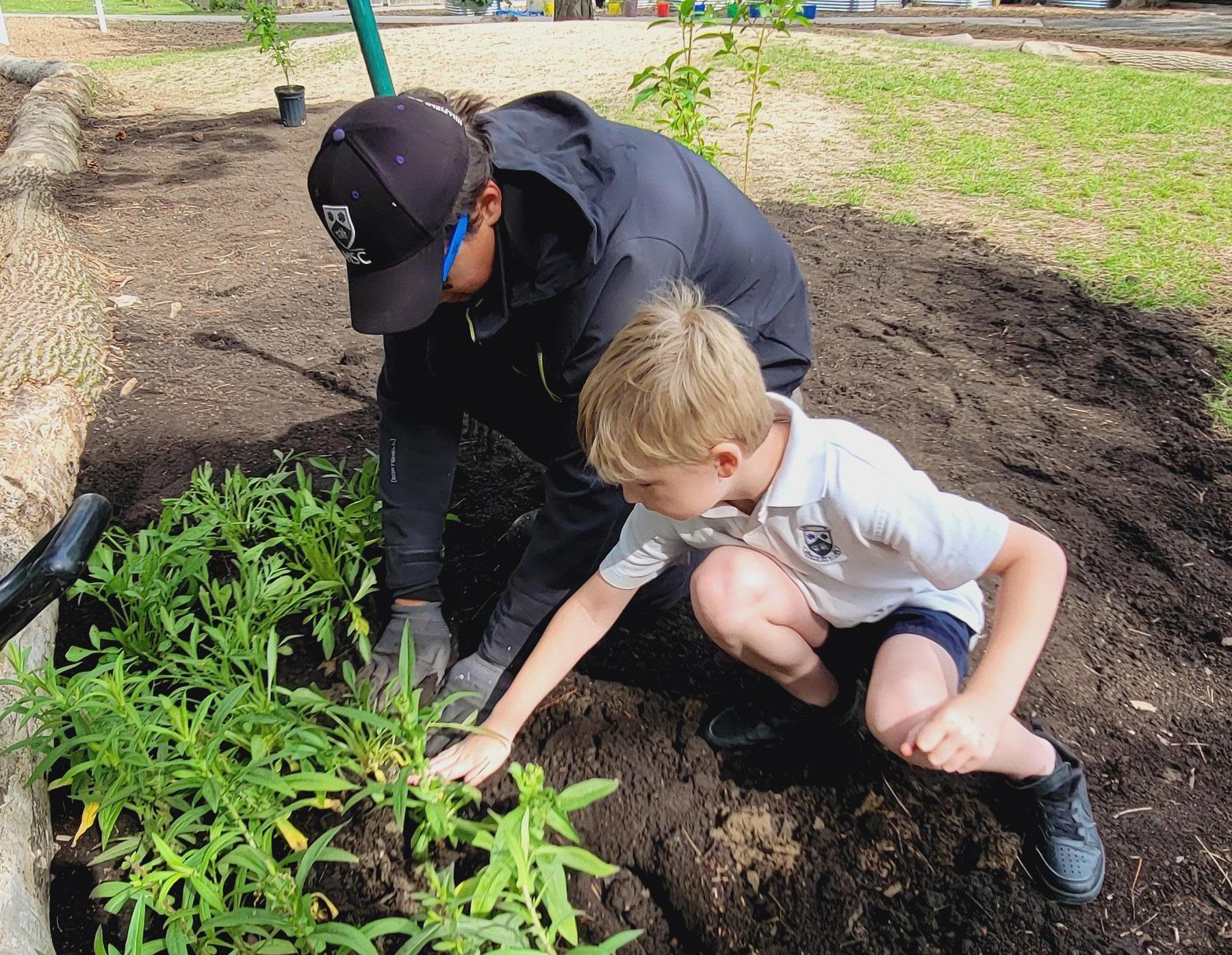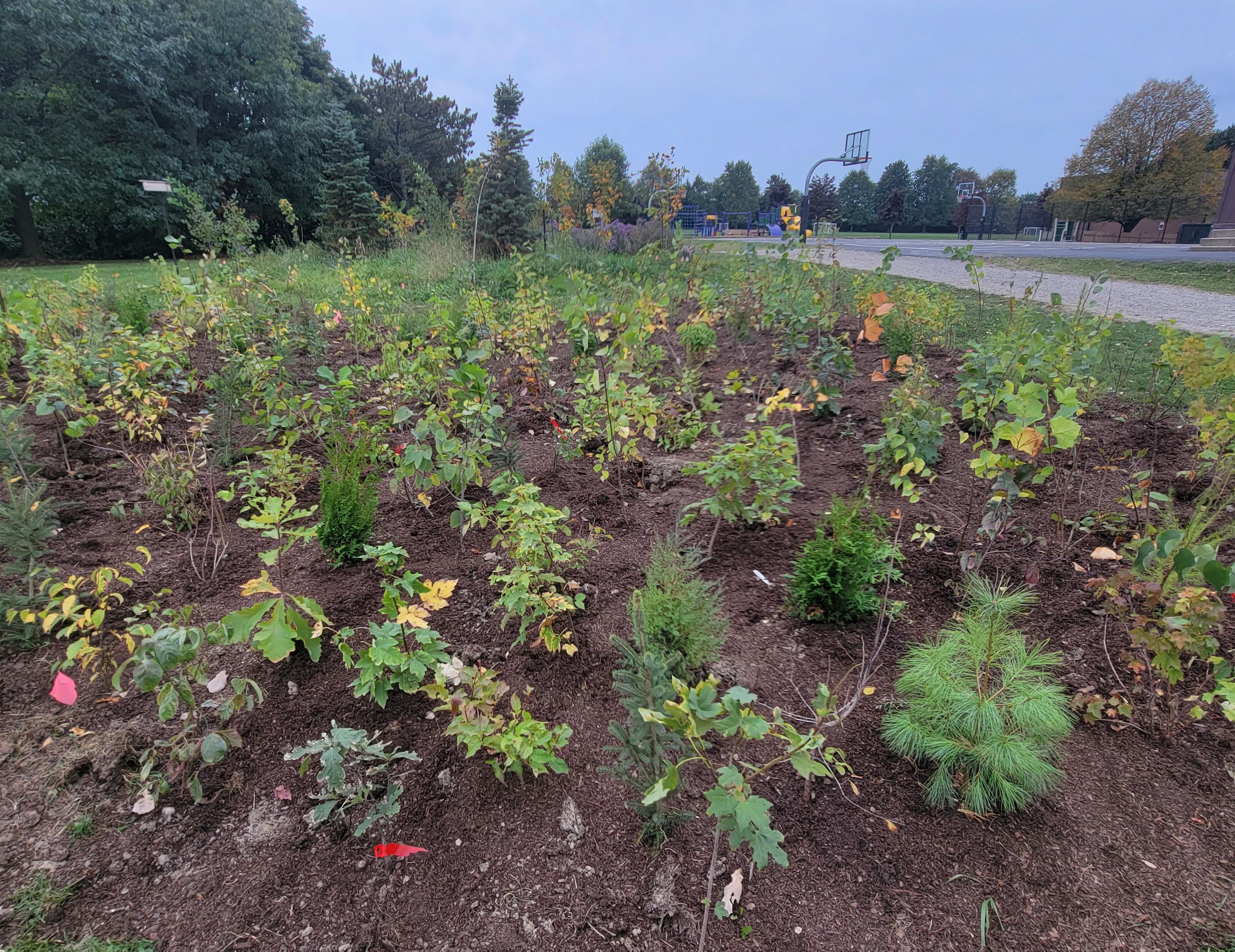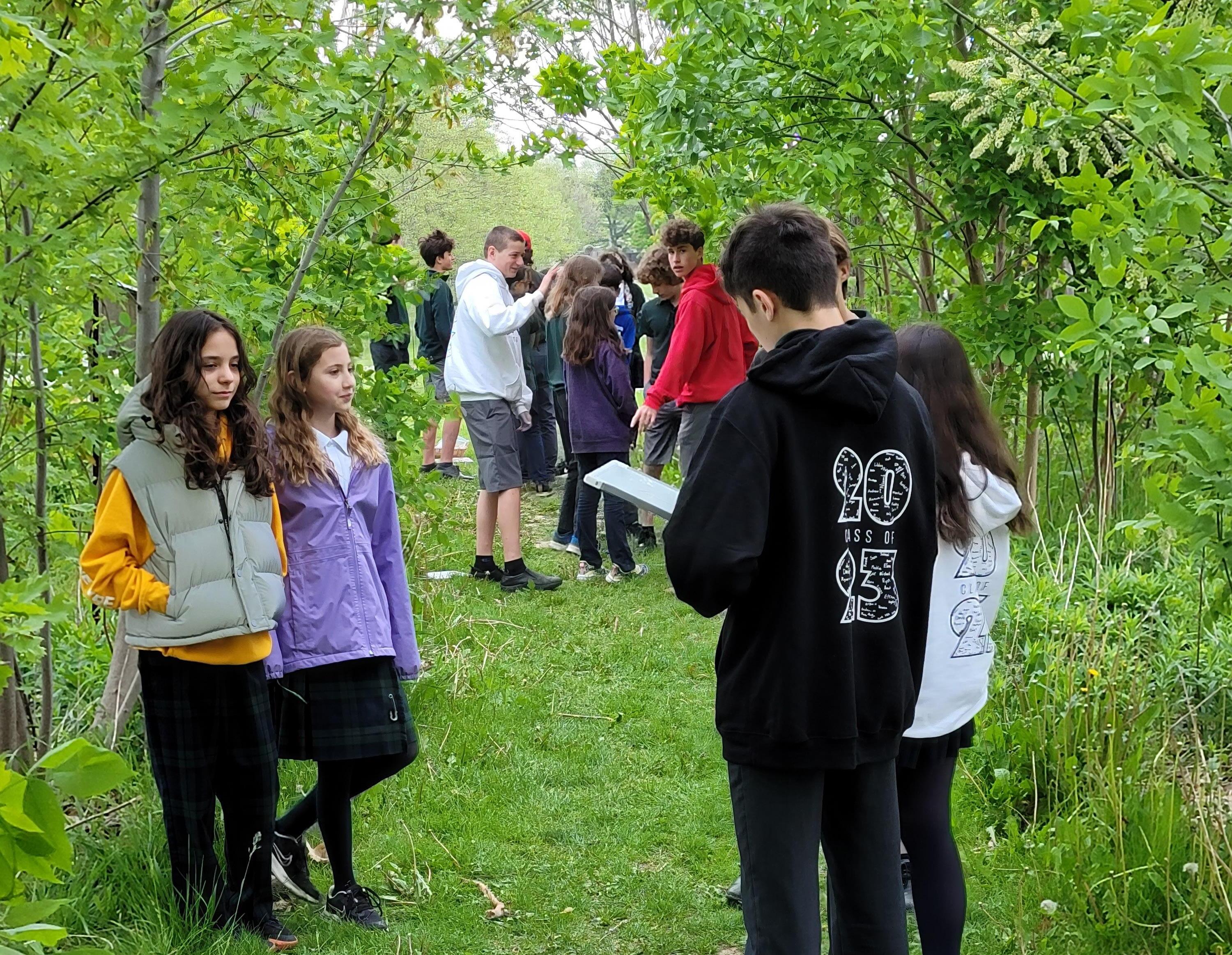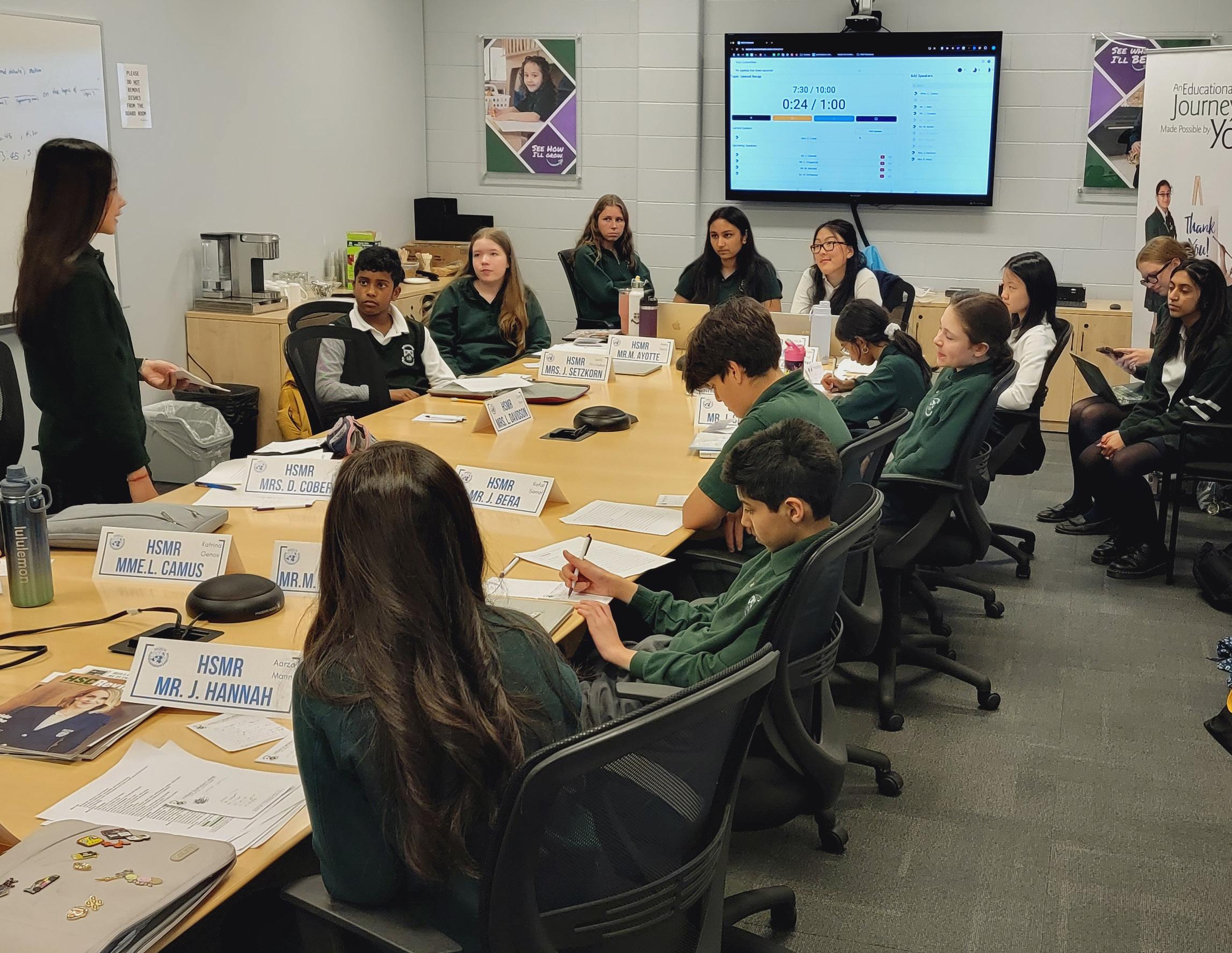EMPOWERING THE FUTURE:
INTEGRATING CLIMATE CHANGE INTO K-12 EDUCATION AT HSC
Building Hope Creating Solutions Inspiring Action

“The best way to predict the future is to create it.”
- Peter Drucker


“The best way to predict the future is to create it.”
- Peter Drucker
Hillfield Strathallan College is situated upon the traditional territories of the Erie, Neutral, Huron-Wendat, Haudenosaunee and Mississaugas.
This land is covered by the Dish With One Spoon Wampum Belt Covenant, which is an agreement between the Haudenosaunee, Anishinabek and other Indigenous nations to share and care for the resources around the Great Lakes.
As members of the learning community at HSC, we are committed to honouring this covenant by working alongside our Indigenous neighbours and building a sustainable relationship with the land that we all cherish.


Biodiversitree - A heritage Red Oak acorn germination project distributed 350 seedling trees to our HSC community.
As an existential crisis, climate change is the defining issue of our time.
We have inherited its challenges and opportunities.
A curriculum inspiring hope and regeneration is the solution.
As the generation that will face the greatest impacts of climate change, our students deserve an education that empowers them to understand, adapt to, and take action on the defining issue of their time. Integrating climate change across every subject in every grade equips them not only with knowledge, but with hope, agency, and the tools to shape a more sustainable future.
UNESCO defines Education for Sustainable Development (ESD) as empowering learners to make informed decisions and take responsible actions for environmental integrity, economic viability, and a just society, for present and future generations, while respecting cultural diversity. Climate change education, within the broader context of ESD, focuses on developing knowledge, skills, and values needed to address climate change mitigation, adaptation, and resilience.
At our College, where stewardship of the land is acknowledged and demonstrated through 5 acres of renewed native habitat, facilities and green infrastructure models, and a visionary climate-ready campus master plan, we believe the next bold step is clear: embedding climate change education across our curriculum.
We are uniquely positioned—not just with a physical landscape and infrastructure that reflects our commitment to sustainability, but with a faculty and community ready to lead. As a College recognized for its leadership and innovation, we have both the responsibility and opportunity to empower our students with the knowledge, critical thinking, and agency to face the climate challenges ahead.
Integrating climate change concepts into our curriculum is not merely an academic initiative—it is an extension of our mission, a reflection of our values, and a chance to cultivate the next generation of informed, adaptable, and solutions-oriented leaders. This project will ensure that climate literacy becomes an essential, cross-disciplinary thread that connects learning with action, theory with lived experience, and our campus with the wider world.
“If we do our job well, there is a future where we don’t need special roles or events to shine a light on sustainability or climate action, because environmental stewardship will simply become a core value of the members of our community.”
– Alex Moffatt, Senior School teacher


As you delve into this booklet, I want to express my profound gratitude for your commitment to HSC’s sustainability learning journey. As a community, we are deeply invested in making HSC a leader in Canadian education, not just in theory, but in the active practice, comprehensive learning, and inspiring teaching of environmental sustainability.
Our commitment is enshrined in HSC’s Climate Action Plan, a robust roadmap guiding our efforts. We are also proud to be one of several schools to formally commit to a Climate & Nature Leadership Pledge, underscoring our dedication to tangible change. Our ambitious goals are clear: to achieve carbon neutrality by 2030 and to become carbon negative by 2050.
We continue to make meaningful progress in tracking and reducing our environmental impact. Our 2024 emissions report reveals significant achievements including 10.47% reduction in emissions intensity compared to our 2019 baseline as well as a 6.37% reduction in overall energy use intensity.
These results reflect a consistent downward trend and position the College ahead of pace to meet our long-term emissions reduction goals. This year-over-year improvement in both emissions and energy performance is a testament to the collective efforts of our entire community.
The curriculum that follows is designed to empower you with the knowledge, skills, and inspiration to be part of this vital work. Together, we can foster a deeper understanding of our planet’s challenges and contribute to a sustainable future.
Climate change is science in action—teaching about it helps students see how data, experimentation, and critical thinking can solve real-world problems.
Examples: advanced energy system thinking, mitigating infrastructures, HSC habitats.
Climate data is a powerful teaching tool. Using real-world statistics makes math meaningful and demonstrates how numbers can drive decisions that protect the planet.
Examples: data analysis, energy cost comparisons, system optimization, data-driven proof.
Exploring climate change through human and physical geography connects students to global systems and social justice, encouraging empathy and informed citizenship.
Examples: policy analysis, historical shifts in energy use, inclusivity and access, stunning examples of regenerative development and design.
Stories shape our future, and through reading, writing, and discussion, students can explore climate change from diverse perspectives and raise their voices for change.
Examples: persuasive writing, critical media literacy, debating, storytelling, DEI perspectives, climate change interpretive panels in multiple languages
Art gives form to complex ideas—when students use creativity to express the impacts and hopes around climate change, they inspire action and awareness.
Examples: storytelling through posters, drama, spoken word, music.
Climate change challenges students to think like designers and engineers. Through hands-on creation, digital innovation, and systems thinking, students can use technology to understand problems and design real-world solutions that support sustainability and resilience.
Examples: building models of renewable energy systems, creating digital advocacy tools such as research-grade citizen science with eBird and iNaturalist.
Climate change affects physical and mental wellbeing. By learning outdoors and examining the connection between healthy ecosystems and healthy people, students can build resilience and social-emotional awareness.
Examples: 1000 hours outdoors project, healthy ecosystems and healthy people, impacts of outdoor environments on physical and mental health; social emotional learning.
“At
HSC, we connect learning with the land to inspire hope and action for a regenerative future. Through hands-on experiences across our 50-acre living landscape, students explore systems thinking, regenerative design, and real-world solutions to the climate crisis. We are cultivating a generation of innovators ready to help our communities and planet thrive.”
– John Hannah Sustainability Leader and Educator
CLIMATE CHANGE EDUCATION SHOULD FOCUS ON THE FOLLOWING LEARNING
Teach the scientific consensus on climate change Foster critical thinking skills and media literacy
Incorporate socio-emotional considerations to overcome feelings of eco-anxiety, denial, and inaction
Use teaching methods that are participatory and place-based
Focus on collective action
Link and strategize with other justice-related issues
Address who benefits and is most affected by collective inaction
This chart with Responding to Climate Change: A Primer for K-12 Education is helpful, clear, and related to the UNESCO Greening Education Guidance Document
“By evolving our programs and outdoor spaces to be more sustainable and climate-conscious, we can inspire students to care for their environment while supporting their physical and mental wellbeing. Every activity becomes an opportunity to lead by example and prepare for a healthier, more sustainable future.”
– Mark Verbeek
K-12 Instructional Chair Health & Physical Education
Observing weather and journaling nature invites children to notice patterns. These skills lay the groundwork for recognizing shifts caused by climate change. When children see water evaporate and condense, they begin to grasp the forces that drive our planet’s systems and how climate change is altering them. When we study the people, foods, and environments of other cultures, we prepare children to care about global challenges.
Exploring HSC’s habitats using the #KindergartenBioBlitz format in different seasons.
Connection to Nature: Understanding how all living things, including people, depend on the environment and developing a sense of awe and wonder about nature.
Climate Basics: Experiencing and documenting weather and seasons.
Sustainability Habits: Simple actions for reducing energy use and waste, e.g. using less, increasing recycling and integrating classroom composters.
Energy Awareness: Explore the sun’s energy and how the albedo effect regulates the planet’s air flow, temperatures and climates.
Community and Responsibility: How to become good stewards of our College and planet by being “Earth Helpers”.
Using outdoor spaces to explore seasonal change, sun/shadows, plant life, and habitats.
“International Biodiversity Day serves as a compelling reminder of the abundant variety of life on Earth and the importance of protecting it. By celebrating this day, the Junior School students are inspired to appreciate nature’s value, understand the threats facing ecosystems, and take action to preserve biodiversity. This year, the Junior School planted native species on our playground. In doing so, the students are taking steps toward protecting the biodiversity on our campus and helping to preserve the planet for themselves and future generations.”
– Jen Adams Junior School Teacher

Exploring & Bonding with Nature: Observing seasonal changes and how plants and animals live harmoniously with the Earth.
Establishing the foundation for a deep personal connection with the natural world: Water flows and collects in different places, like puddles. Natural curiosity guides a kindergarten bioblitz and classroom inquiry.
Basic Sustainability: Identifying ways to care for the Earth (e.g., turning off lights, recycling, and early stewardship foundations).
Solar-Specific Questions: Experience multiple types of energy and investigate them.
Living and Non-Living Things: Understanding the needs of living things, exploring non-living things and the interplay between the living and non-living world, discovering how the living and non-living worlds impact their lives and understanding that, like all living things, humans are part of nature and rely on it for survival.
Our Choices Matter: Exploring how small actions (e.g., conserving energy by turning lights off) can help the Earth, e.g. on bright days, we can still do our work when classroom lights are off.
Solar-Specific Questions: Compare indoor and outdoor temperatures. How are we connected to the natural environment? How do our choices (needs and wants) impact the environment? Indigenous perspectives?
Nature walks in naturalized habitats to spark questions.
Kindergartenbioblitz
Comparing solar-related concepts. Where is it warmer and cooler? Different objects have different temperatures in the sun, even on a cold winter day.
Habitats and Communities: How animals and plants depend on their surroundings.
Waste Reduction: The importance of reducing (first), reusing (second), recycling (third) and disposing of waste in a landfill (last resort).
Solar-Specific Questions: How do animals grow, change and use energy? How are the air and water connected, and how are they important to us? How do our consumer choices (needs and wants) affect the air and water and animal growth in the environment? Indigenous perspectives?
Energy Awareness: Introduction to renewable energy (solar, wind, and geothermal from compost).
Soil and Plants: How composting helps soil and food production.
Solar-Specific Questions: How can we use the energy from the sun? How might we address the UN SDGs? How might we grow food sustainably for us and our neighbours?
Mapping habitats in outdoor classrooms or naturalized areas.
Creating art projects from recycled materials.
Asking maintenance to tour our waste streams and where our waste goes at HSC and beyond.
Touring the College’s solar panels and creating a “Where energy comes from” poster.
Managing a classroom vermicomposter
Planting seeds and how compost enriches soil.
Identifying leaves and studying plant life helps children build a bond with nature. This knowledge becomes deeply relevant as they awaken to the diversity of life and what sustains it, and how our society and economy relies on biodiversity and energy flow. Systems thinking begins to emerge as students explore inputs, outputs, parts, purpose and side effects of systems.
Analyzing College waste data and creating action plans for composting and recycling.
Ecosystems and Interdependence: How human actions affect biodiversity.
Carbon Footprint: What it is and how to reduce it.
Energy Innovations: Introduction to renewable energy (e.g., solar, wind, geothermal).
Circular Economy: Waste reduction through composting, recycling, and reusing; regenerative thinking.
Student Action Teams: Joining Green Teams to take responsibility for campus initiatives as “Earth Heroes.”
Create posters promoting HSC’s renewable energy and address common myths.
Hands-on projects using EV chargers or greenhouse-grown plants, build small wind turbines or solar ovens.
Exploring the food-energy-water connections through the food forest.
“Our students are with us for a relatively short period of time in their lives, but in the context of environmental stewardship, the impact we have on them can and should be everlasting and intergenerational.”

Ecosystems in Balance: How human activities impact ecosystems and biodiversity.
Waste as a Resource: How composting and recycling creates new value.
Solar-Specific Questions: What features of local habitats are essential for animal and plant survival? How do weather and climate change the Earth? What is light? How can light be used to produce energy? What is our relationship with the Earth? How might we take better care of the Earth?
Human Impact on Earth: How energy use and waste production affect the planet.
Alternative Energy: Comparing renewable and non-renewable energy sources.
Solar-Specific Questions: How do the weather and geography of an area determine how inhabitable it is? How do physical and chemical changes affect the properties of matter? How does the weather change over time, and how is this related to climate?
Participating in waste audits and brainstorming ways to improve.
Studying how food forests or vegetable gardens mimic natural ecosystems.
Experimenting with small solar-powered gadgets.
Conducting an energy audit of classrooms to recommend energy-saving tips.
Climate Systems: Understanding climate zones, weather patterns, and the impact of human activities.
Sustainability Practices: Exploring ways to conserve water, energy, and biodiversity.
Solar-Specific Questions: How do environmental changes affect the organisms that live there? How do we investigate electricity, renewable energy, and non-renewable energy? How do countries compare with Canada regarding renewable energy and other sustainable practices?
Measuring the school’s carbon footprint and presenting findings.
Investigating the impact of heat-pump technology on energy use.
At this age, students are ready to question systems, challenge assumptions, and explore solutions—climate change education gives them the chance to connect across disciplines, empowering them to see themselves as changemakers and integrative problem solvers in a complex world.
Climate Science: Understanding causes and impacts of climate change.
Energy Transition: Benefits and efficiencies of alternative energy solutions.
Regenerative Design: Planning for energy-efficient buildings and green infrastructure.
Advocacy and Leadership: Developing projects and skills to influence College and community sustainability practices.
Conducting energy audits of classrooms and presenting findings.
Building and testing small-scale solar-powered devices.
Engaging with climate action frameworks like EcoSchools and DoorNumberOne.
Survey to gather opinions on local green projects, analyzing whether people hold misconceptions or biases.
Create a podcast/blog post/video to share hope and regeneration with the school and community.
“Using systems such as geothermal heating and solar energy not only reduces our carbon footprint, and uses renewable more efficient energy, it’s incredibly valuable to our students’ learning. They can engage directly with these real world systems and as such, this encourages STEM learning through project-based learning. Through all of this, students gain an understanding of climate change, energy challenges, and sustainable solutions.”
– Jeff Cober Maintenance Team Member

Climate Change Science: How greenhouse gases contribute to global warming.
Energy Transition: Why renewable energy is essential for the future.
Solar-Specific Questions: Science and Geography Focus: How does solar energy compare to other energy sources regarding efficiency and environmental impact? What factors influence the amount of solar energy generated at our school (e.g., weather, seasons, panel angle)? How can solar power help reduce greenhouse gas emissions in our community?
Building small wind or solar-powered models.
Researching how the school’s EV chargers contribute to sustainability, and calculating the cost/benefit of EVs.
Inquiry that focuses on real economic and environmental impacts of green infrastructure, analyzing real-life examples of successful and contested green projects.
Systems Thinking: Interconnections between water, food, energy systems and food security.
Leadership in Sustainability: How students can influence change in their community. How do you talk to others about climate change and the need for individual action?
Solar-Specific Questions: Science and Math Focus - What patterns can we observe in the daily and monthly solar energy production data? How do the physical properties of solar panels enable them to generate electricity from sunlight? What is the relationship between the energy generated and the school’s energy consumption?
Designing a waste reduction campaign for the school.
Exploring the impact of the school’s diesel/gas/electric bus fleet on emissions.
Analyze news articles or social media posts for bias and misinformation.
Design an infographic for stories of positive progress and good news (start with HSC’s Colin B Glassco Foundation and Trachoma disease reductions in Africa).
Senior School students step into the roles of informed citizens and future leaders. Integrating climate change across disciplines equips them with the critical thinking, innovation, and ethical reasoning they need to face and address real-world challenges with purpose and confidence.
Annually updating HSC’s climate action plan.
Collaborating on large-scale energy, water, food, transportation, composting or waste management systems.
Analyze articles, social media, and advertisements for misinformation about green technologies. Explore why and how misinformation spreads.
Host debates on controversial green infrastructure proposals and practices, with students researching and representing different perspectives (e.g. mock trial - Canada vs. Youth on climate change impacts)
Creating capstone projects on sustainability, using campus infrastructure as a living lab.
Global Responsibility: Understanding international climate agreements and social justice issues, and localizing them.
Advanced Energy Systems: Deep dive into solar arrays, EV systems, geothermal heating technologies, and emerging technologies.
Regenerative Practices: Exploring food forests and Miyawaki Method forests, biodiversity restoration, net-zero principles and other ways of shrinking human footprints.
Entrepreneurship in Sustainability: Developing climate-focused business ideas or campaigns.
Youth as Changemakers: Leading initiatives like Earth Month, policy advocacy, cross-school mentoring and workshops, and community education projects.
“Senior School is when students take shape as young adults and citizens. Integrating sustainability and environmental education into our curriculum in meaningful and authentic ways can have vital impacts at this stage: students learn to see sustainability as a lens through which all other disciplines can be viewed, rather than as a standalone topic; they begin to appreciate the stakes associated with climate change, understanding both the scale of the major global impacts and the subtlety of local, small-scale secondary or tertiary effects; they experience the power of individual and collective actions as they develop agency and exercise their voices; they develop the skills, knowledge and vision to become the leaders who will shape the Green Workforce.”

– Alex Moffatt Senior School Teacher
Earth Systems and Resources: How human activities modify Earth’s physical systems. Surface runoff impacts urban flooding and water quality - existing Chedoke Creek study and stewardship projects.
Global Climate Challenges: Understanding local and global impacts of climate change. Analyze how urban development affects surface runoff and heat island patterns.
Solar-Specific Questions: Mathematics and Sustainable Development Focus - How do we calculate the efficiency of the solar panels, and what factors could improve it? What is the financial payback period for the solar panel installation at HSC? How does our solar energy production compare to average household energy needs?
Energy and Sustainability: Exploring energy production and its environmental impacts.
Climate Solutions: Investigating emerging strategies to mitigate and adapt to climate change for HSC.
Solar-Specific Questions: What role does solar energy play in mitigating climate change? What are the long-term benefits and challenges of transitioning to renewable energy sources? How does solar power technology work, from photons to electricity?
Analyzing renewable energy data from the school’s solar panels.
Mapping the environmental benefits of campus initiatives like naturalized habitats or rainwater runoff infrastructures (we still have major flooding issues).
Experimenting with the efficiency of renewable energy systems.
Creating proposals for expanding sustainability initiatives on campus.
Global and Local Responsibility: Understanding policies, innovations, and experiencing leadership in climate action.
Regenerative Practices: Moving beyond sustainability to restore functional ecosystems.
Leadership: Engaging in the management and documentation of HSC’s habitat corridors and potentially managing building systems where interactions are viable (HVAC, Solar, eventual “living building” concept for new construction.
Developing a capstone project that applies sustainability principles to a real-world problem (e.g., designing a zero-waste cafeteria).
Collaborating with local partners to promote environmental stewardship.
Student involvement in regenerative design projects (at HSC &/or in the community).
Marc Ayotte
Eleonor Kerr
Jackie Birch
John Bulger
Special thanks to John Hannah, former faculty member and Sustainability and Learning Landscapes Lead, who put in countless hours to bring this document to life and to instill in HSC students a love of our land and our environment.